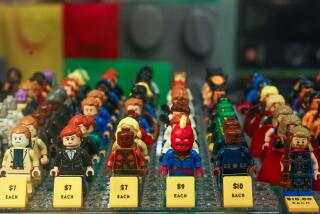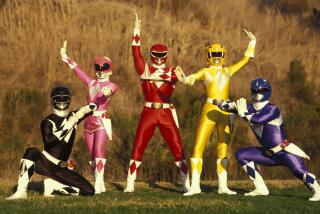Morphin Madness : Toys: The Power Rangers are battling real live villains--counterfeiters and middle-aged impostors in spandex. But the creator insists supply will keep up with demand this year.
- Share via
We’ve come to know them as the squeaky-clean su per-heroes who routinely overcome impossible odds to neutralize monsters from other worlds.
But now, the Mighty Morphin Power Rangers may be up against one villain even they cannot vanquish. And no, it’s not sold-out toy stores or cranky parents.
This holiday season, the Rangers’ No. 1 nemesis may well be the mob.
With demand still outstripping supply of the coveted action figures, the sale of unlicensed Mighty Morphin look-alikes is reportedly becoming big business in the underworld.
“It is no secret that organized crime is involved in all high-level counterfeiting. And yes, they are here, right here in the world of toys,” says Angie Small, vice president of legal affairs for Power Rangers’ creator Saban Entertainment.
Using private investigators, armed marshals and undercover operatives, the Burbank-based Saban plans to spend more than $1 million by Christmas cracking down on real live bad guys.
To protect “the good name and the goodwill” of the Power Rangers, Small says her company launched a battle in March to fight the growing unauthorized use of the Rangers’ image by career criminals and others--including middle-aged guys in Spandex suits.
Since then, she says, about $10 million in counterfeit Rangers merchandise has been seized. “And that is just the tip of the iceberg,” adds Small. (And speaking of tips, boys and girls, call (800) MORPHER to report suspected impostors.)
“We’re now cooperating with the FBI to put together some major stings--none of which I can discuss in detail at this time, of course,” she says.
Since their television debut in the fall of 1993, the Power Rangers have cornered the market on campy, high-kicking after-school entertainment. And as the adventures of a multiethnic team of teens with attitude soared into TV history by capturing as much as 99% of its 2-to-11-year-old audience, so did sales of the matching toys.
But supply--which was short last December--still has not kept pace with the sudden and overwhelming demands for all things Morphin.
A year ago, even Santa couldn’t get his mitts on the bright-colored, multijointed full-action figures. Desperate parents were offering bribes, threats and four to five times retail price to guarantee there would be a Mighty Morphin-something under the tree by Christmas morning.
This year, there may be no need to stalk delivery trucks or steal from other shoppers’ baskets. “I’ll be really shocked if there’s a shortage,” says Trish Stewart, marketing director for Bandai America, Power Ranger manufacturer. For one thing, there is a whole new range of Ranger-based stuff to buy: backpacks, flatware, bike helmets, pajamas, underpants, flatware and inflatable TV armchairs.
Consumers may not find the exact item they are looking for--the White Ranger Tommy and his new alter ego, White Tiger, may be scarce, for example--but Stewart says she expects about 10 times as many toys to be on the shelves for the 1994 holidays. And that’s not including unlicensed faux-Ranger items.
“We still get some reports on fights breaking out over toys and that sort of thing,” Stewart says, “but it’s nothing close to the desperation we witnessed last year.” Shoppers who need help finding a particular item can call the Cerritos-based Bandai’s consumer service department for updates on local toy shipments.
*
While last year’s buy-or-die market fueled buying frenzies across the nation, few analysts anticipated its spinoff into an underground market that would reach beyond U.S. borders. Although enforcement efforts against Ranger counterfeiters so far have focused on American violators, the violations themselves are occurring worldwide, attorney Small says.
Most of the merchandise is manufactured in one of Bandai’s 16 Asian or Mexican plants, but by the end of the year, the company will add four more factories--including one in Colorado--in an effort to match a growing European demand for the toys.
Although the privately owned Bandai toy maker won’t release exact figures, some industry analysts estimate that by New Year’s Eve, the Rangers will have earned $1 billion.
So why not share? “What we’re concerned about with the counterfeits is the quality, the integrity of the merchandise. Some of these knockoff toys are truly dangerous. Arms and legs, even heads come off,” Small says.
Among the targets of the anti-knockoff campaign are Power Ranger impersonators who are showing up more and more at birthday parties, store openings, even car dealerships. “Unfortunately, none of these impersonators is trained in the martial arts. And even more unfortunately, most of them seem to be middle-aged persons who don’t look nice at all in Spandex,” says a representative for Saban. “Parents should be aware that we do not make Power Ranger costumes in adult sizes.”
Until the counterfeiting crisis, the biggest troubles facing the Power Rangers were charges from some parents and TV critics that the show was inciting its littlest imitators to violence.
A Scandinavian network briefly banned the show after a 5-year-old girl was beaten and left to die in the snow by three little boy playmates. As it turned out, none of the boys had ever seen the show, although they did mention something about Teenaged Mutant Ninja Turtles to investigators.
More recently, a Canadian channel has suspended the show while it decides whether complaints about gratuitous violence demand an overhaul of children’s programming.
While unwelcome, none of the criticism has been unexpected, says Peter Dang, president of Saban’s Children’s Entertainment Network. “We look at ourselves as a live action cartoon and fantasy. But we really make an effort to respect how much the Rangers have become role models and to examine how we use martial arts to advance the action of the show.”
“This is good entertainment. We look at it as quite good fun,” adds Frank Ward, president of Renaissance Atlantic, the developer of the series, which has a cast of “silly” characters.
“I don’t think there’s a 6-year-old in this country who believes that a pineapple with a traffic light stuck in his head is a very scary monster.”
Indeed, it is hard to take the show’s evil elements very seriously, with monsters such as the pineapple guy and Dang’s favorite, Pudgy Pig--who managed to devour the world’s food supply until the Power Rangers made him throw it all up.
But when it comes to genuine no-good nastiness, who can compete with the mob?
Will the Power Rangers outdo the inexorable forces of real evil in the world?
Stay tuned.
More to Read
The biggest entertainment stories
Get our big stories about Hollywood, film, television, music, arts, culture and more right in your inbox as soon as they publish.
You may occasionally receive promotional content from the Los Angeles Times.










